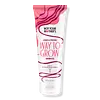What's inside
What's inside
 Key Ingredients
Key Ingredients

No key ingredients
 Benefits
Benefits

 Concerns
Concerns

 Ingredients Side-by-side
Ingredients Side-by-side

Water
Skin ConditioningCocamidopropyl Betaine
CleansingSodium Lauroyl Methyl Isethionate
CleansingHeptyl Glucoside
Sodium Methyl Oleoyl Taurate
CleansingSodium Cocoyl Isethionate
CleansingSorbeth-230 Tetraoleate
EmulsifyingPolyquaternium-7
Phenoxyethanol
PreservativeSodium Chloride
MaskingCitrus Aurantium Dulcis Peel Oil
MaskingCaprylyl Glycol
EmollientCitrus Limon Peel Oil
MaskingDecyl Glucoside
CleansingPanthenol
Skin ConditioningHexylene Glycol
EmulsifyingMannitol
HumectantEthylhexylglycerin
Skin ConditioningPhosphatidylcholine
EmulsifyingGlycerin
HumectantPolyquaternium-10
Biotin
AntiseborrhoeicXimenia Americana Seed Oil
EmollientSorbitan Laurate
EmulsifyingPelargonium Graveolens Flower Oil
MaskingSr-(Wasp Spider Polypeptide-1 Oligopeptide-178)
Skin ConditioningAloe Barbadensis Leaf Juice
Skin ConditioningCetyl Alcohol
EmollientSodium PCA
HumectantSodium Lactate
BufferingPotassium Sorbate
PreservativeSodium Benzoate
MaskingArginine
MaskingAspartic Acid
MaskingGlycine
BufferingCitrus Aurantium Bergamia Fruit Oil
MaskingCeramide NP
Skin ConditioningStearamine
Sorbitan Oleate
EmulsifyingXanthan Gum
EmulsifyingAlanine
MaskingSerine
MaskingValine
MaskingThreonine
Isoleucine
Skin ConditioningProline
Skin ConditioningDimyristyl Phosphate
CleansingHistidine
HumectantPhenylalanine
MaskingGlycoproteins
Skin ConditioningOligopeptide-2
Skin ConditioningWater, Cocamidopropyl Betaine, Sodium Lauroyl Methyl Isethionate, Heptyl Glucoside, Sodium Methyl Oleoyl Taurate, Sodium Cocoyl Isethionate, Sorbeth-230 Tetraoleate, Polyquaternium-7, Phenoxyethanol, Sodium Chloride, Citrus Aurantium Dulcis Peel Oil, Caprylyl Glycol, Citrus Limon Peel Oil, Decyl Glucoside, Panthenol, Hexylene Glycol, Mannitol, Ethylhexylglycerin, Phosphatidylcholine, Glycerin, Polyquaternium-10, Biotin, Ximenia Americana Seed Oil, Sorbitan Laurate, Pelargonium Graveolens Flower Oil, Sr-(Wasp Spider Polypeptide-1 Oligopeptide-178), Aloe Barbadensis Leaf Juice, Cetyl Alcohol, Sodium PCA, Sodium Lactate, Potassium Sorbate, Sodium Benzoate, Arginine, Aspartic Acid, Glycine, Citrus Aurantium Bergamia Fruit Oil, Ceramide NP, Stearamine, Sorbitan Oleate, Xanthan Gum, Alanine, Serine, Valine, Threonine, Isoleucine, Proline, Dimyristyl Phosphate, Histidine, Phenylalanine, Glycoproteins, Oligopeptide-2
Ingredients Explained
These ingredients are found in both products.
Ingredients higher up in an ingredient list are typically present in a larger amount.
Biotin is a B vitamin that is naturally produced by our bodies. It is also called Vitamin H.
Our bodies use biotin in the metabolism process. It also helps our bodies use enzymes and move nutrients around. A biotin deficiency can lead to brittle hair and nails.
More research is needed on applying biotin topically. However, taking biotin orally has been shown to help nourish the skin, hair, and nails. They play a role in forming skin-hydrating fatty acids.
Biotin is water-soluble. It can be found in foods such as fish, eggs, dairy, nuts, and meat. Vitamin H stands for "haar" and "haut". These are the German words for hair and skin.
Learn more about BiotinCocamidopropyl Betaine is a fatty acid created by mixing similar compounds in coconut oil and dimethylaminopropylamine, a compound with two amino groups.
This ingredient is a surfactant and cleanser. It helps gather the dirt, pollutants, and other impurities in your skin to be washed away. It also helps thicken a product and make the texture more creamy.
Being created from coconut oil means Cocamidopropyl Betaine is hydrating for the skin.
While Cocamidopropyl Betaine was believed to be an allergen, a study from 2012 disproved this. It found two compounds in unpure Cocamidopropyl Betaine to be the irritants: aminoamide and 3-dimethylaminopropylamine. High-grade and pure Cocamidopropyl Betaine did not induce allergic reactions during this study.
Learn more about Cocamidopropyl BetaineEthylhexylglycerin (we can't pronounce this either) is commonly used as a preservative and skin softener. It is derived from glyceryl.
You might see Ethylhexylglycerin often paired with other preservatives such as phenoxyethanol. Ethylhexylglycerin has been found to increase the effectiveness of these other preservatives.
Panthenol is a common ingredient that helps hydrate and soothe the skin. It is found naturally in our skin and hair.
There are two forms of panthenol: D and L.
D-panthenol is also known as dexpanthenol. Most cosmetics use dexpanthenol or a mixture of D and L-panthenol.
Panthenol is famous due to its ability to go deeper into the skin's layers. Using this ingredient has numerous pros (and no cons):
Like hyaluronic acid, panthenol is a humectant. Humectants are able to bind and hold large amounts of water to keep skin hydrated.
This ingredient works well for wound healing. It works by increasing tissue in the wound and helps close open wounds.
Once oxidized, panthenol converts to pantothenic acid. Panthothenic acid is found in all living cells.
This ingredient is also referred to as pro-vitamin B5.
Learn more about PanthenolPhenoxyethanol is a preservative that has germicide, antimicrobial, and aromatic properties. Studies show that phenoxyethanol can prevent microbial growth. By itself, it has a scent that is similar to that of a rose.
It's often used in formulations along with Caprylyl Glycol to preserve the shelf life of products.
Polyquaternium-10 is an ammonium salt of hydroxyethylcellulose. It is a white and granular powder used as a film-former and anti-static agent.
This ingredient is commonly found in hair conditioning products. According to a manufacturer, its positive charge makes it great for absorbing hair proteins. The manufacturer also states this ingredient helps with curl retention.
For haircare friends: this ingredient is not a silicone.
Learn more about Polyquaternium-10Sodium cocoyl isethionate is a natural ingredient from coconut oil. It is an ultra gentle cleanser that gives a nice foam without drying the skin or impacting the skin barrier.
The amount of foam created depends on the amount of sodium cocoyl isethionate used in the product.
This ingredient also helps improve the spreadability of a product.
Learn more about Sodium Cocoyl IsethionateSodium Lauroyl Methyl Isethionate is a cleansing ingredient. It is a surfactant, meaning it helps gather dirt, oil, and other pollutants. This helps them be rinsed away easily.
Water. It's the most common cosmetic ingredient of all. You'll usually see it at the top of ingredient lists, meaning that it makes up the largest part of the product.
So why is it so popular? Water most often acts as a solvent - this means that it helps dissolve other ingredients into the formulation.
You'll also recognize water as that liquid we all need to stay alive. If you see this, drink a glass of water. Stay hydrated!
Learn more about Water